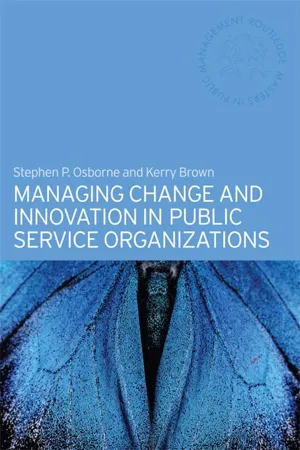
eBook - ePub
Managing Change and Innovation in Public Service Organizations
This is a test
- 272 pages
- English
- ePUB (mobile friendly)
- Available on iOS & Android
eBook - ePub
Managing Change and Innovation in Public Service Organizations
Book details
Book preview
Table of contents
Citations
About This Book
The context and environment of public services is becoming increasingly complex and the management of change and innovation is now a core task for the successful public manager. This text aims to provide its readers with the skills necessary to understand, manage and sustain change and innovation in public service organizations. Key features include:
- the use of figures, tables and boxes to highlight ideas and concepts of central importance
- a dedicated case study to serve as a focus for discussion and learning, and to marry theory with practice
- clear learning objectives for each chapter with suggestions for further reading.Providing future and current public managers with the understanding and skills required to manage change and innovation, this groundbreaking text is essential reading for all those studying public management, public administration and public policy.
Frequently asked questions
At the moment all of our mobile-responsive ePub books are available to download via the app. Most of our PDFs are also available to download and we're working on making the final remaining ones downloadable now. Learn more here.
Both plans give you full access to the library and all of Perlego’s features. The only differences are the price and subscription period: With the annual plan you’ll save around 30% compared to 12 months on the monthly plan.
We are an online textbook subscription service, where you can get access to an entire online library for less than the price of a single book per month. With over 1 million books across 1000+ topics, we’ve got you covered! Learn more here.
Look out for the read-aloud symbol on your next book to see if you can listen to it. The read-aloud tool reads text aloud for you, highlighting the text as it is being read. You can pause it, speed it up and slow it down. Learn more here.
Yes, you can access Managing Change and Innovation in Public Service Organizations by Kerry Brown, Stephen Osborne in PDF and/or ePUB format, as well as other popular books in Business & Business General. We have over one million books available in our catalogue for you to explore.

Part I
Introduction

Chapter 1
Change and innovation in public service organizations
Planned and emergent phenomena

LEARNING OBJECTIVES
By the end of this chapter you should:




KEY POINTS OF THIS CHAPTER



KEY TERMS






CHANGE AND INNOVATION IN PUBLIC SERVICES AND IN PUBLIC SERVICE ORGANIZATIONS
For much of the last century, public service organizations (PSOs) were the embodiment of stability. Invariably integrated as part of government as a whole, these organizations were classical Weberian hierarchical bureaucracies. The organizational emphasis was upon incremental growth and development and upon a planned approach to the administration of public services.
However, as the twentieth century drew to a close, this picture began to change. These classical public service bureaucracies had been well suited to a stable and slow-changing environment. A range of factors in the late twentieth century, though, conspired to change this environment. These factors are analysed in more detail in Chapter 2. However, the key changes included:





These factors led to a change in nature of public services provision. Far from this role being the assumed priority of the state, it became increasingly a task undertaken by a range of organizations in what has become known as the plural state (Osborne and McLaughlin 2002). This comprises a range of PSOs from the government, non-profit and business sectors that need to collaborate in the provision of public services. The evolution of this plural state has also seen a shift, first from the administration of public services to their management – and then from their management to their governance, where the governance of plural relationships has become the central task for the provision of effective public services (Kickert et al. 1997).
All these developments have put a premium upon the skills of managing change and innovation in public services.
Change and innovation in public services
Change and innovation are over-lapping phenomena. However, it is important from the outset to be clear about where they converge and where they diverge – as well as their impact upon the management and delivery of public services (Box 1.1).
Change is a broad phenomenon that involves the growth and/or development of one or more of a number of elements of a public service. These include:




By contrast, innovation is a specific form of change. Its nature is explored in more detail in Chapter 7. Put simply, however, innovation is discontinuous change.
Rather than representing continuity with the recent past it represents a break with the past. What had been acceptable or adequate for the provision of public services in the past will no longer be so – their provision will require new structures or skills that mark a break with this past experience. This discontinuity might involve the creation of a new organization, the meeting of a newly established need
(such as HIV/AIDS in the 198...
Table of contents
- Cover Page
- Halftitle Page
- Frontother Page
- Title Page
- Copyright
- Table Of Contents
- List of figures, tables and boxes
- Acknowledgements
- Abbreviations
- Part I Introduction
- Part II Managing Change in Public Service Organizations
- Part III Managing Innovation in Public Service Organizations
- Part IV Conclusions
- Appendices
- Index